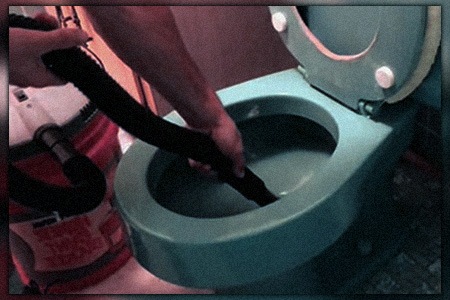How to Unclog a Toilet When Nothing Works
Author: Anne Cowart | Editor: Omar Alonso
Review & Research: Jen Worst & Chris Miller

There's nothing more frustrating than dealing with a stubborn toilet clog that refuses to budge, no matter what you try. If you're tired of reaching for the plunger every time your toilet gets backed up, this is for you! We're going to find out how to unclog a toilet when nothing works.
We'll explore the common causes of stubborn toilet clogs and share alternative methods to unclog your toilet when traditional plunging tactics fail. Learn how everyday household items like baking soda, vinegar, and dish soap can rescue you in these dire situations.
Common Causes of Toilet Clogs

Knowing the common causes of toilet clogs can help you prevent future plumbing headaches. These include flushing inappropriate items, build-up of waste and debris, and excessive toilet paper usage.
Flushing Inappropriate Items
When non-flushable materials such as paper towels, sanitary pads, wet wipes, and other hygiene products are discarded in the toilet, it can lead to challenging blockages that are difficult to remove. Some people even flush hair, which is a no-no.
For instance, imagine accidentally dropping a small toy or cosmetic item into your toilet bowl—these objects can easily become trapped in narrow pipes and result in stubborn clogs.
To avoid facing potential plumbing emergencies caused by improper flushing habits, only flush biodegradable waste products designed for sewer systems.
Build-Up of Waste & Debris
Over time, accumulated deposits from various sources, such as hair, paper, and foreign objects, can block your toilet drain or trap.
Aging drain lines are particularly susceptible to clogs due to their reduced capacity for handling significant amounts of waste and debris. For instance, low-flow toilets produced before 1997 often have narrower pipes that struggle with modern-day usage demands.
Furthermore, blocked air vents or sewer line blockages can contribute significantly to drainage issues by restricting airflow within the pipe network.
Excessive Toilet Paper Usage

Though specifically designed to dissolve quickly when used appropriately, an abundance of toilet paper can create stubborn blockages within your plumbing system.
It’s not uncommon for individuals to use far more than necessary, either due to personal preference or simply not realizing the consequences that excessive amounts can bring about.
To prevent such issues from arising in your bathroom, it's crucial to educate all household members on the importance of using only what is needed and being mindful of what they flush down the drain.
Taking this extra step will significantly reduce instances of clogging while also promoting better hygiene and sanitation practices throughout your home.
What to Do Before Unclogging the Toilet
If your toilet is clogged and won't unclog itself over time, take some necessary measures before unclogging it. Afterwards, we'll show you how to unclog a toilet when nothing works.
Turn Off the Water Supply
If your toilet threatens to overflow, it's best to immediately turn off the water supply. Locate the shut-off valve, typically behind the toilet, and rotate it clockwise to stop the water flow.
Prepare for Potential Overflow
First, grab some gloves and some type of plunger (or whichever tool you use to unclog the toilet).
Next, place old towels or newspapers around the toilet base to catch the water that may spill during the unclogging process. This will help minimize potential damage and make cleanup easier.
Alternative Methods To Unclog A Toilet When Plunging Doesn't Work
When your trusty plunger fails to unclog your stubborn toilet, try one of the alternative methods below to restore your bathroom's functionality.
Baking Soda & Vinegar
When mixed, baking soda and vinegar can create a chemical reaction that can dissolve the clog in some cases. You can also unclog a drain with salt after this loosens it up.
To use this method, pour one cup each of baking soda and vinegar down the drain. Allow it to sit for about 30 minutes before pouring hot water down the drain to remove any remaining debris.
Dishwashing Detergent & Boiling Water
When it comes to dishwashing detergent and boiling water, the slippery soap can help lubricate the clogged pipe and allow it to clear.
Add a few drops of liquid dish soap to the bowl after trying the hot water trick, then pour a pot of boiling water into the bowl from waist height.
Dishwashing detergent with boiling water is effective because it breaks down any oils or grease in the drain system, facilitating efficient flow through downstream sewer lines or septic systems.
Plumbing Snake or Auger

When plunging doesn't work, a plumbing snake or auger can be a great alternative to unclog the toilet. This tool is specially designed for clearing out blockages in pipes and drains.
Using a plumbing snake or auger involves inserting its long flexible cable into the clogged drain until it hits the obstruction. Once you reach this point, rotate and push the cable deeper into the pipe while turning its handle clockwise simultaneously.
The twisting motion helps break up any blockage within the piping so that water can flow freely again. Remember to pull back after each turn of about 180 degrees, repeating these steps until everything passes through smoothly without resistance.
Wire Coat Hanger
If plunging doesn't work, you can try using a wire coat hanger as an alternative method to unclog your toilet.
First, unravel and straighten the hanger so that one end is pointed. Carefully push the pointed end into the clogged area of your toilet and start prodding and twisting it in a circular motion until you feel that the obstruction has been cleared.
While this DIY technique is not recommended for severe blockages or if there's any risk of damaging your plumbing system, it's an easy hack to try before calling a professional plumber.
Always wear gloves when dealing with household sanitation issues to protect yourself from harmful bacteria and germs. Tools like wire coat hangers should always be done carefully to avoid scratching porcelain toilets or causing further damage.
Chemical Drain Cleaners
Chemical drain cleaners can be a quick and easy solution to unclog a stubborn toilet. While they may seem like a good idea, it's important to note that these products should only be used occasionally for slow drains. They are ineffective against actual stoppages.
Leading drain cleaners such as Drano Max Gel Clog Remover and Bio-Clean can dissolve hair, grease, soap scum, and other organic materials that clog your pipes. Without physically removing the clog with some mechanical device, this is your best bet for how to unclog a toilet when nothing works, though it may take multiple applications.
In addition, chemical drain cleaners contain harsh chemicals that could cause harm if misused. Thus, you should carefully follow the manufacturer's instructions when using these products.
Wet-Dry Vacuum

A wet-dry type of vacuum can come to the rescue if you're dealing with a stubborn toilet clog caused by a solid object that cannot be easily broken down, like a child's toy. It’s both powerful and user-friendly.
First, make sure never to insert the vacuum hose directly into the toilet bowl to avoid potential overflow.
Instead, use the flexible vacuum hose without any attachments and wrap it with an old cloth for an airtight seal. Carefully guide the covered hose into the toilet bowl, ensuring the seal remains tight. This way, you can maximize the vacuum's suction and increase the chances of dislodging the clog.
When to Call a Professional Plumber

If you've attempted all the alternative methods and still can't unclog your toilet, calling a professional plumber can save you from potential disasters and ensure your plumbing issues are resolved.
Continuous Clogs Despite Attempted Methods
If your toilet continues to clog despite trying multiple methods, it may be time to call a professional plumber. A trained plumber can provide a more comprehensive and permanent solution.
Ignoring continuous clogs could lead to bigger problems like leaks and bursts in the pipes, which will cost more than fixing the clog itself. Don't hesitate to call for professional plumbing services if you've tried multiple unclogging methods without success.
It's better to address the issue early on before it becomes a severe plumbing emergency. Part of the issue may simply be that you need to make your toilet flush better so it doesn't clog up over time.
Foul Sewage Smells
Foul sewage smells are a common indicator of clogged drains in bathrooms and toilets. These odors can be extremely unpleasant and potentially dangerous if left untreated.
If cleaning the shower drain doesn't resolve the smell, it's recommended to call a professional plumber for further inspection.
In general, it's important to only flush appropriate items down the toilet (water, waste, and toilet paper) to prevent clogs and bad smells.
Severe Damage to the Toilet
It is essential to take a clogged toilet seriously, as it can cause severe damage to your toilet if left unattended. Water overflowing from the bowl can seep into the floor or walls and create water damage around the bathroom.
Additionally, constantly flushing the toilet without resolving blockages will worsen things and lead to an expensive repair or replacement.
Regarding plumbing emergencies like this, prevention is always better than cure. Regular maintenance of your plumbing fixtures can help in avoiding these kinds of issues from occurring in the first place.
That’s How to Unclog a Toilet When Nothing Works
Dealing with a clogged toilet is a frustrating and messy experience. However, there are alternative methods to unclog a toilet when plunging doesn't work, such as baking soda and vinegar, dishwashing detergent and boiling water, or chemical drain cleaners.
It's important to know when to call a professional plumber for continuous clogs despite attempted methods, foul sewage smells, or severe damage to the toilet. Otherwise, that's how to unclog a toilet when nothing works.




